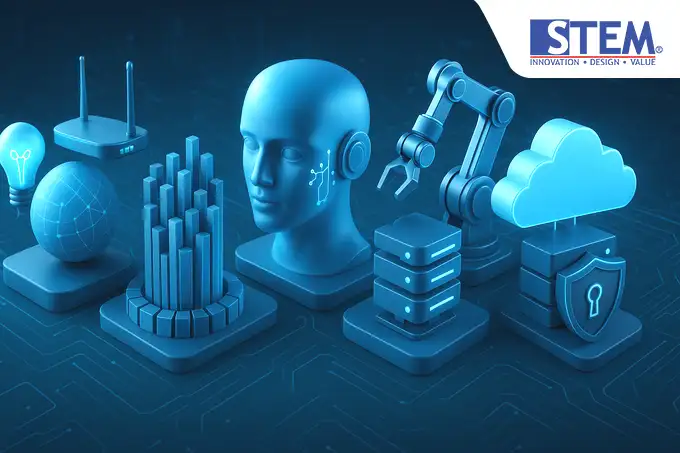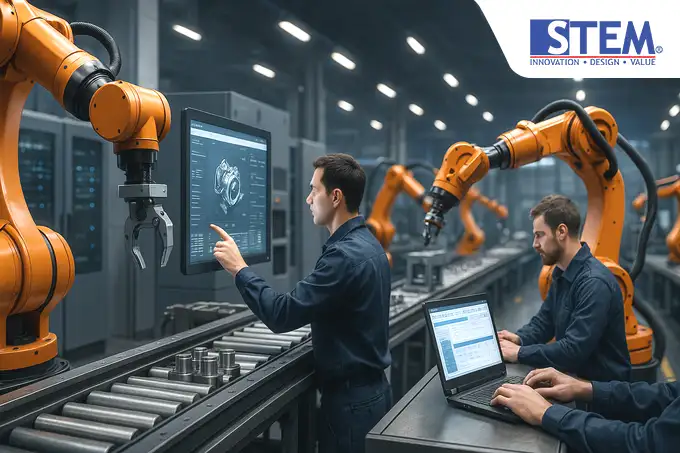Greetings to all manufacturing professionals across the archipelago. If you’re reading this, chances are you’re grappling with how to navigate the complexities of Industry 4.0. Machines are getting smarter, data is multiplying, customers are more demanding, and competition is fiercer than ever.
Amidst all this, the term “digital transformation” keeps echoing from every direction—but what does it truly mean? Where should one begin? And are we—manufacturers in Indonesia—genuinely prepared?
Digital transformation in the manufacturing sector is not a hollow buzzword. It is an imperative, a survival strategy in this era of data-driven automation.
This article serves as a practical guide. We’ll explore everything from A to Z: the definition, the urgent need, tangible benefits, applicable areas, key technologies, and the steps for implementation. I’ll keep it straightforward, concise, and minimally technical—so every level of management can follow with ease.
What Does Digital Transformation Truly Mean in Manufacturing?
Digital transformation is far more than purchasing an ERP system or deploying IoT sensors. It is about reimagining the entire operational model using digital technologies—from production workflows to decision-making processes and customer service.
Unlike basic digitization (such as shifting from paper logs to Excel sheets), true digital transformation delves deeper. We’re talking about production systems that can “think,” analyze real-time data, and initiate autonomous improvements. This is the essence of the smart factory—of Industry 4.0.
A simple example: a machine that detects early signs of malfunction via sensors and sends an alert to a technician. This is no longer a fantasy. The technology exists—it’s merely a question of whether we choose to embrace it.
Contact Us for a Consultation!
Why Is Digital Transformation So Urgent for Your Manufacturing Business?
Let’s be candid. If your factory still operates like it did a decade ago, you’re sitting on a ticking time bomb.
- Global Competition – Neighboring countries like Vietnam and Thailand have already leapt forward. We are falling behind.
- Rising Consumer Expectations – Customers now demand higher quality, faster delivery, and lower prices. Without efficiency, how can we compete?
- Operational Efficiency – Smart factories reduce costs through automation and data-informed decisions.
- Business Resilience – COVID-19 taught us that digitally adaptive factories can continue operating—even in times of crisis.
Digital transformation isn’t a passing trend—it’s a matter of survival.
Discover More Here!
The Tangible Benefits of Digital Transformation: From Efficiency to Profitability

Is digitalization really profitable? The data says yes:
- Increased Productivity – Automation minimizes idle time and human error.
- Lower Costs – Sensors prevent catastrophic failures and reduce costly downtime.
- Improved Quality – Digital quality control is far more precise than manual inspection.
- Sharper Decisions – Real-time dashboards enable faster, more accurate responses.
- New Business Models – You can offer equipment as a service (product-as-a-service), not just as a one-time sale.
All these outcomes contribute directly to higher profits. So if someone claims “digital transformation is expensive,” I have just one reply: “The real cost is in not transforming at all”.
Core Pillars & Key Areas for Digitalization: Where Should You Begin?
Digital transformation isn’t a one-department job—it’s a cross-functional initiative. Here are areas to start with:
- Production Floor (Smart Factory) – IoT monitoring and automated production lines.
- Supply Chain – Real-time tracking of raw materials and finished goods.
- Maintenance – Shift from reactive to predictive maintenance using sensor data.
- Quality Control – AI-driven vision systems for automated defect detection.
- R&D – Simulate products using digital twins before actual production.
- Sales & Service – Implement CRM, chatbots, automated ordering, and responsive after-sales service.
The Enabling Technologies Behind This Transformation

You don’t need to be a software engineer to benefit from these innovations. Just understand how they solve your factory’s real problems.
- IoT (Internet of Things) – Sensors embedded in machinery for real-time monitoring.
- AI & Machine Learning – Analyze production data to predict failures and optimize performance.
- Big Data Analytics – Turn operational data into actionable insights.
- Cloud Computing – Access and store data securely from anywhere.
- Automation & Robotics – Eliminate repetitive, labor-intensive tasks.
- AR/VR – Train technicians or conduct remote inspections.
- Cybersecurity – Essential for safeguarding interconnected systems.
Practical Steps to Begin Your Company’s Digital Transformation
Digital transformation is not a sprint—it’s a marathon. But you can start today with these concrete steps:
- Assess Readiness
- Create a Digital Strategy
- Choose a Pilot Project
- Develop Talent and Culture
- Integrate Systems
- Evaluate and Scale Up
Overcoming Common Challenges in Manufacturing Digitalization
Yes, there are challenges. But each one has a solution with the right mindset:
- Worried about costs? Focus on return on investment.
- Facing employee resistance? Involve them from the beginning.
- Lacking digital talent? Partner with tech communities.
- Struggling with legacy systems? Use middleware to bridge gaps.
- Concerned about data security? Start with foundational protections.
Don’t wait for perfection. Start now. Learn along the way.
Conclusion
Digital transformation in manufacturing is not a luxury—it’s your lifeline for survival and growth. We’ve explored:
- What digital transformation is
- Why it matters
- Its real-world benefits
- Key technologies and digitalization areas
- How to begin and tackle obstacles
Begin evaluating your factory’s digital readiness today. Don’t wait for your competitors to evolve first. In this industry, the slow are not just left behind—they may vanish altogether.


